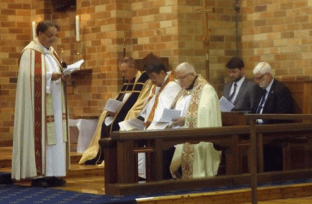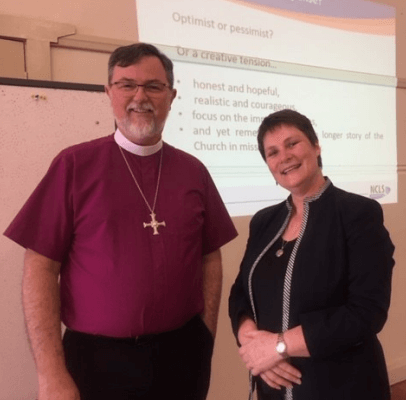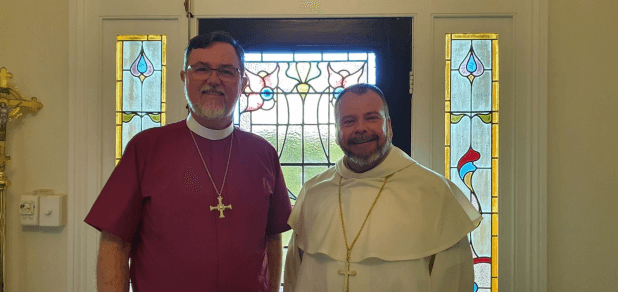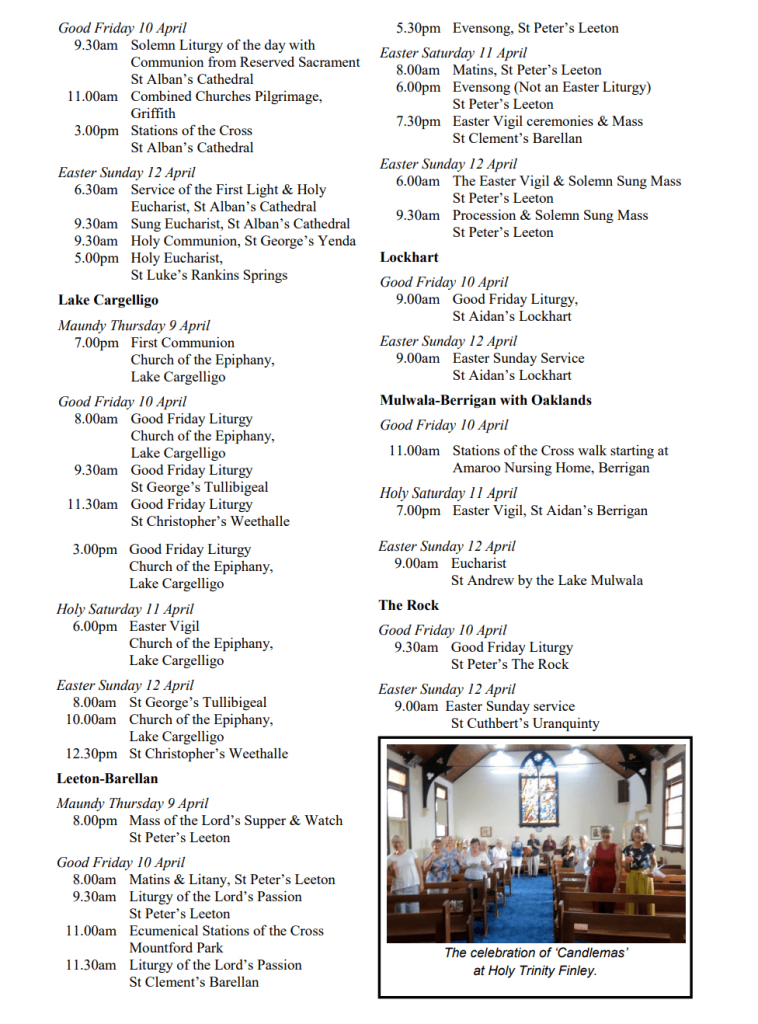Installation of Cathedral Canons
The six new Cathedral Canons who were elected at the Diocesan Synod in October were installed at a special Eucharist during the Diocesan Clergy Conference on 20th February.
The October Synod passed a new Cathedral Ordinance to reestablish the Cathedral Chapter to create better links between St Alban’s Cathedral (mother Church of the Diocese) and the Churches and people of the Diocese.
The new Canons were elected as Members of the Cathedral Chapter and include three ‘Lay Canons’ for the first time in the Diocese’s history.
The Clerical Canons are:
- The Rev’d Canon Robert Murphy (Leeton)
- The Rev’d Canon Paul Kumasaka (Lake Cargelligo)
- The Rev’d Canon Wayne Sheean (Deniliquin)
The Lay Canons are:
- Canon Ken Martin (Coleambally/Darlington Pt)
- Canon James Walsh (Assistant Chancellor/Griffith)
- Canon Marion Barker (Barham)

The Rev’d Canon Wayne Sheean, the Rev’d Canon Paul Kumasaka, the Very Rev’d Robert Harris (Dean), the Rt Rev’d Donald Kirk (Bishop), Canon Ken Martin, Canon James Walsh, Louise Potter (Registrar) and the Rev’d Canon Robert Murphy. [Canon Marion Barker was unable to be present]
The Very Reverend Rob Harris, Dean of St Alban’s Cathedral, presented the Canons with their Certificates of Election and Appointment and installed them as Canons of the Cathedral Church of St Alban the Martyr.
As Members of the Cathedral Chapter, the Canons undertake among other duties to foster the development of the Cathedral Church as the Mother Church of the Diocese and facilitate the role of the Cathedral Church as a place of gathering for the parishes and people of the Diocese; to approve and safeguard the function of the Cathedral Church as the parish Church of the Cathedral parish and to approve any alteration or additions to the fabric of the Cathedral Church.

The Dean praying for the newly Installed Canons
Where to from here?

The Bishop with Dr Ruth Powell
The Director of Research at the National Church Life Survey (NCLS), Dr Ruth Powell was a special guest at the Diocesan Clergy Conference at St Alban’s Cathedral Hall, Griffith on 20th February.
Dr Powell presented a revealing snapshot of the changing shape of the Australian Church and its relationship to Australian society.
Since 1991 the NCLS team has been running the five-yearly National Church Life Survey, the largest, long-running survey of local church life in the world. In 2016, around 240,000 individuals from 3,000 Australian churches in 20 denominations and over 7,000 Church leaders completed surveys.
As Dr Powell explained, the relationship between the Australian Church and society is complicated.
‘Only four in ten Australians agree that ‘religion is good for society’. The 2019 Australian Community Survey run by NCLS Research in November also found that around four in ten (36%) were neutral or unsure, whereas some two in ten (23%) disagree that religion is good for society.
- Church attendance has begun to plateau It is old, and often repeated, news that the Australian church has been declining over recent decades. However, we have observed that since 1990 the rate of decline of monthly church attendance has slowed and the decline in weekly church attendance has now plateaued.
- Protestant churches are growing When considered together, Protestant churches are growing in numbers. While a closer study of denominations shows that Catholic and Mainstream Protestant churches (e.g. Anglican, Uniting, Lutheran) continue a pattern of overall decline, other Protestants have experienced moderate growth between 1991 and 2016. Pentecostal movements have experienced high growth.
- The size order of the top five denominations has changed In 1991 in terms of churchgoers, the top five denominations in order of size were Catholic, Anglican, Uniting, Baptist and ACC (AoG). By 2016 this order had changed to reflect the differing growth patterns of attenders: Catholic, ACC (AoG), Anglican, Baptist and Uniting.
- Inflow of new arrivals has been largely stable People can join churches having previously been in other churches or they can come from outside the church community. Considering all denominations together, the inflow of new arrivals into churches between 1996 and 2016 has been largely stable.
- Local church leaders believe they are effective in their roles The 2016 NCLS Leaders Survey enabled local church leaders to reflect on their roles and experiences of ministry. By ‘local church leaders’ we mean the local minister/pastor or lay leader in a senior leadership role. While ministry can be a demanding role, when asked how they would rate their effectiveness in their current role over the previous few months, most ministers rated their effectiveness in their role highly or very highly.
- Current attenders are more likely to be positive about church than previously Healthy churches help people in their relationship with God, with each other and with the wider community. They also have vital leadership and directions for the future.
- When I started giving my adolescent daughter Accutane I was really worried how heavy it can be for her liver and kidneys and other systems. Our doctor said it was risky, because the negative effects are harsh. Luckily they were not as huge as the result was for her!
- Faith: Growth in faith
- Worship: Inspired during worship services
- Service: Informal acts of service and in church-based service groups
- Faith-sharing: Look for opportunities to share faith and involved in evangelistic groups
- Vision: Commitment to the church’s vision
- Innovation: Agree church is ready something new has increased

Re-dedication brings new Light
Two magnificent stained-glass windows from St Paul’s Church in Hay have found a new home in the north window of the sanctuary of Christ Church St Laurence in Sydney.
The windows which feature St Peter and St James were painstakingly removed from St Paul’s Church and restored by Rick Allen of Heritage Decorative Glass in Moss Vale. The Bishop of Riverina, The Right Rev’d Donald Kirk was the guest preacher at the Solemn High Mass and re-dedication of the windows at Christ Church St Laurence on Sunday 23rd February, the Feast of the Transfiguration.
The windows have been donated to Christ Church St Laurence in memory of Dorothy and Arthur Nethercote whose son, John is a parishioner.
In blessing the windows, Bishop Donald prayed:
‘O Lord God, the whole world is filled with the radiance of your glory: Accept our offering of these windows which we now rededicate to you for the adornment of this place and the inspiration of your people.
Grant that, as the light shines through its many colours, so our lives may show forth the beauty of your manifold gifts of grace; through Jesus Christ our Lord, who lives and reigns with you in the unity of the Holy Spirit, one God, for ever and ever.’ The windows were originally installed in St Paul’s Church, Hay in 1958 when it was the ProCathedral of the Diocese of Riverina. The window depicting St Peter holding his keys was given to St Paul’s by Marion Sinclaire Austin (1877-1968) of Narrandera in memory of her parents, John William Kennedy (1847-1935) and Leana Sinclaire Kennedy (1849-1929) and her brother, Ronald Sinclaire Kennedy (1877-1918).
Leana and John were born in Ireland. They arrived in Hay in 1885 and John soon became Medical Officer at the hospital as well as Mayor of Hay.
The second window shows St James the Great with scallop shell on the right shoulder of his cape and pilgrim’s gourd attached to his staff. The window was given to St Paul’s in memory of Ruth Alfreda Olive Peters (1896-1961) by her family and friends. Ruth settled in Hay in the 1930s, becoming a ‘devoted worker for St Paul’s’ and member of the Comrades of St George.

Bishop Donald censing the
Re-Dedicated Windows

Rowena Ginns, Fr Robert Murphy and
Fr Bill Ginns represented Hay Parish

Bishop Donald preaching at the
Solemn High Mass
Water brings two Bishop Together

The Right Reverend Donald Kirk,
Bishop of the Anglican Diocese of Riverina
The Most Reverend Columba MacBeth-Green OSPPE
Bishop of the Catholic Diocese of Wilcannia-Forbes

New Archdeacon
There was a decided atmosphere of joy and fulfillment on January 17 as the congregation of the Corowa parish came together to celebrate and participate in the Induction of their new Rector, the Reverend Peter Richards. The parish church of St John was filled with parishioners, local residents and ministers from other denominations in the area as well as members of clergy from around the Diocese.
At the beginning of the service Father Peter sat quietly with his youngest daughter, Abbyghail. Following the first hymn, Abbyghail, who stood in as the representative from the Parish of Applecross in Perth where Fr Peter had been ministering, presented her father to Bishop Donald.
Following Fr Peter’s grant of license and placement within the priest’s stall, the congregation witnessed his collation as the Archdeacon of the Diocese by Bishop Donald. Fr Peter’s appointment as Archdeacon rounds out and completes the reformation of the diocesan leadership team. In fulfilling this important role, The Venerable Peter begins a vital ministry of supporting Bishop Donald within the life of the diocese.
The Eucharist that followed was filled with life and music as the congregation sang modern upbeat hymns reminding us of our service to our communities in the name of Christ. The service was followed by a social gathering in the hall with plenty to eat and drink supplied by the Ladies Guild and other members of the Parish, reinforcing our dependence on our neighbours within the community.
In welcoming Fr Peter to the parish, Warden Roy Monte expressed the relief of the parish to receive into their midst a priest whom he felt would fit well into the Corowa district after a long wait for this event. Bishop Donald later suggested that historically the ecclesiastical definition of the Archdeacon’s role was to be the “crook” of the Bishop’s crozier. It is left to the reader’s imagination as to whether this is to mean that the Venerable Peter is to reach into unreachable places to secure lost sheep under adverse conditions or some other nefarious undertaking as suggested by the word “crook”. No matter the final understanding, Fr Peter stated he was looking forward to the challenges ahead in both the Diocesan and Parish arenas.

Bishop Donald Inducting Fr Peter Richards as Rector of Corowa

Fr Peter Richard with his daughter
Abbyghail who presented him at the
Induction
New Priest in Mulwala

Fr Geoffrey & ‘Goldie’

Glenda Brooker welcomes Fr Geoffrey
to the Parish
Before a congregation of about 50 people from Mulwala and Berrigan and neighbouring communities as well as most of the Diocesan clergy, Father Geoffrey Humble was commissioned by Bishop Donald as Priest-in-Charge of the parishes of Mulwala/Berrigan with Oaklands on Friday the 7th February.
The Commissioning service was held at the church of St Andrew’s -by-the-Lake at Mulwala. At the beginning of the Commissioning service, Father Neil Hicks, Fr Geoffrey’s previous parish priest and old friend from Geelong presented Fr Geoffrey to Bishop Donald and the congregation.
Fr Geoffrey and his beloved Labradoodle, ‘Goldie’ are now settling into the presbytery at Mulwala after what he describes as a comedy of errors.
“First my removalist’s truck died which meant I lost two weeks. I finally arrived in Mulwala on a stinking hot day of 44C on 31 January 2020. This was followed by another, even hotter day which saw the ‘swampy’ evaporative cooler give up the ghost. Welcome to the Riverina!” Fr Geoffrey’s journey to the priesthood and his appointment at Mulwala has been a varied and circuitous one. Born in Geelong in 1948 he was baptised into the Presbyterian Church in his grandmother’s loungeroom ‘with a large Staffordshire china sugar bowl acting as the font’.
“For some reason, in my early childhood I declared that I did not like the Presbyterian Sunday School at St Andrews, so was taken with some friends to St Matthew’s Church of England in East Geelong. Mum was an Anglican, while dad was a Presbyterian. There I remained at St Matthews until a fundamentalist schism shattered the congregation and drove many of us away about 1968.”
After finishing school at Geelong High, Geoffrey worked as a stock controller at Benders Diesel Service, North Geelong for 13 years. Through his involvement in the Geelong Theatre Company, playing minor roles and working backstage, Geoffrey met his future wife, Roslyn. “Ros and I were married in 1981 at St Andrew’s Uniting Church (my old family Presbyterian church) with a choral wedding led by the choir and supported by our theatre friends in the congregation. It was the church’s one and only choral wedding.” After moving to Warrnambool where Geoffrey worked as an insurance agent, he and Ros joined the congregation of Christ Church Anglican Church. They both sang in the choir which Geoffrey directed for some years and became eucharistic assistants.
While living in Warrnambool Geoffrey decided to go ‘back to school’ to study for a Bachelor of Arts degree and then a Postgraduate Diploma of Education (Secondary). He subsequently taught at Hawkesbury High School, Cobden Technical School and Brauer Secondary College in West Warrnambool.
Geoffrey went on to complete a Master of Arts (Organisational Communication) degree while lecturing in media and communication at the Warrnambool and Geelong campuses of Deakin University. In March 2006 everything changed when Ros was diagnosed with ovarian cancer. Geoffrey resigned his teaching positions and training work to become Ros’s full-time carer.
To keep his mind active Geoffrey enrolled in a Master of Theology degree by distance education through the United Faculty of Theology at Trinity College in Melbourne.
“We fought the cancer beast for here-and-a-half years until Ros went peacefully and happily to God on 18 December 2010.
“After a period of feeling sorry for myself, I decided I needed to put back some of the love and compassion that we had been given, so in May 2012 I was licensed to operate as a lay minister at Holy Trinity church at Ceres. Then in September that year I was appointed as secondary school chaplain at Stawell Secondary College.
At the beginning of his chaplaincy, Geoffrey felt a strong call to ministry. After serving as Catechist-in-Charge of the parish of Mortlake, Fr Geoffrey was ordained a deacon in 2013 and priested in the Diocese of Ballarat in 2014. He remained as Priest-in-Charge at Mortlake and later did locum work at Ararat and Colac parishes until 2019.
Holy Week and Easter Services


Important Changes to NSW
Child Protection Law
From 1st March 2020 persons in religious ministry or persons providing religion-based activities to children ie SRE teachers, ‘Messy Church’ coordinators, youth group leaders, are mandated to report when they have reasonable grounds to suspect that a child is at risk of significant harm. This is a result of amendments to the Children and Young Persons (Care and Protection) Act 1998 (Care Act).
It is most important that if you have any concerns about child abuse or child protection issues in your church you call the Safe Ministry Helpline 1800 070 511 for assistance in compliance with these changes.
These changes remind us of the need for the ongoing implementation of our Safe Ministry policy and protocols.
For more information on mandatory reporting you can visit the Department of Communities and Justice website at https://www.facs.nsw.gov.au/ families/Protecting-kids/ mandatory-reporters
Farewell Rev'd Nola Cox
Reverend Nola Cox was farewelled by parishioners and friends after her final service as Priest with Oversight at St Aidan’s Church, Lockhart on Sunday 29th December 2019.
More than 35 people including representatives from every denomination in Lockhart joined in farewelling and thanking Rev’d Nola for her service to the community of Lockhart since she was made an Honorary Deacon for Lockhart Parish in 2001.
Rev’d Nola was thanked particularly for her dedication and commitment in running the ‘Kids Club’ After School program in Lockhart. Although Rev’d Nola has officially retired, she will still hold a PTO Licence and be available to do occasional services on request. Rev’d Nola and her husband Graham are planning to stay in Lockhart for the foreseeable future so Rev’d Nola will still be able to participate in Church activities. “I will continue ministry to children and aged for as long as I have the strength,” Rev’d Nola said.
New Priest in Finley
The Reverend Walter Firth has been appointed as Priest-inCharge of the Parish of Tocumwal/Finley with Jerilderie. Fr Walter was formally commissioned as Priest-inCharge on Wednesday 4th March 2020 at a service in Holy trinity Church, Finley.
Fr Walter comes to the Diocese with his wife Katherine and their daughter, Georgiana. He will begin in a part-time capacity in the Parish for about six months. This will allow Katherine to complete further studies in Melbourne and fulfill her responsibilities as a General Practitioner in the medical practice where she currently works.
Fr Walter will begin by being in the Parish on Saturdays, Sundays and Wednesdays with the intention of taking up full-time ministry later this year.
Christmas around the Diocese
St Alban’s Cathedral Griffith Many community families of all generations and denominations gathered for the annual 6:00pm Crib Service at St Alban’s Cathedral on Christmas Eve and it is a joy to welcome over 300 people each year. The service is run by the children and teenagers of the parish including Yenda and Rankins Springs . One of the traditions of the service is to bring Mary into the Cathedral riding a Shetland pony, led of course by Joseph.
For many years, Nigel the pony was always trailered in by Julieanne Raymond, a parishioner of St Luke’s, Rankins Springs. Sadly Nigel died in 2018 however his sister Molly, not as tall, is now part of our Christmas worship and very popular with the children after the service, as families gather on the front lawn of the Cathedral for fellowship . This service has developed and grown to be the largest church-based Christmas service in the community. Our Cathedral Parish family look forward to the Crib Service continuing into the future as an evangelical outreach to families in the community.
Fr Rob Harris (Dean & Rector) Hand knitted Crib Scene presented to St John’s Barham by Tracey Timms St Thomas’ Narrandera St Thomas’ once again held an annual ‘Festival of Light’ service at 11.00pm on Christmas Eve to celebrate the light that was coming into the world through the birth of God’s Son — Jesus. The Service was attended by many of the faithful who held lit candles as we processed in and sang “Once in Royal David’s City”. All who attended were touched by the whole event. The service finished as the hour passed midnight.
Bishop Donald writes ...
Lent is a time of renewal and hope. So often we have used the language of penitence and abstinence, of self-denial and sacrifice, that we have as Christians come to view the Season of Lent as an uncomfortable time that focusses on our sin and failure. Then we seem to punish ourselves through this time as if to make amends for all that only to go back to all the things we have denied ourselves during Lent after Easter. What are we doing? What should this Lenten Season really be about? First and foremost Lent is the time of preparation for the celebration of the great mystery of Jesus death and resurrection; of the wonder that God chose to die for humanity in order to reveal the true nature of divine love in the gift of Life Eternal. This great mystery is at the heart of our Christian Faith. We celebrate it every time we celebrate the Eucharist together.
Lent is about reminding us of what Jesus did for humanity and the love and forgiveness of God freely given to us through this great mystery. We do not need to somehow make up for our sins and failures before God or earn the forgiveness he offers. All we are asked to do is accept it by honouring Jesus.
Secondly, Lent is about reminding us of our Baptism through which we are members of Christ’s Church and share in the promise of this great mystery. It is about us renewing within ourselves the faith and trust in God that has brought us to be part of the Church.
We are in Year A of the three year cycle of readings. The Gospel readings for this year are the ancient usage of the Christian Church for teaching Catechumens (those preparing for Baptism at Easter). It is worthwhile for us to pay particular attention to these Gospel passages each week as they remind us of who Jesus is and what he has done for us.
Thirdly, Lent us about renewing within ourselves spiritual discipline. We can all get lazy about our faith, about our prayer life and bible reading. Lent helps us to refocus our spiritual discipline so that we can become more committed to what we believe, more committed to worshipping the one in whom we believe in the company of other believers, and more spiritually aware of God’s action in our lives; something that can and should continue well beyond the celebration of Easter.
If we can practice these things in our lives:
- preparing for the celebration of the great mystery of Jesus death and resurrection,
- pay attention to the Gospels of Lent as a renewal of our Baptismal Faith,
- refocus our spiritual discipline to be more prayerfully committed to our faith,
then we will truly discover what Lent is about and find our faith and lives enriched.


